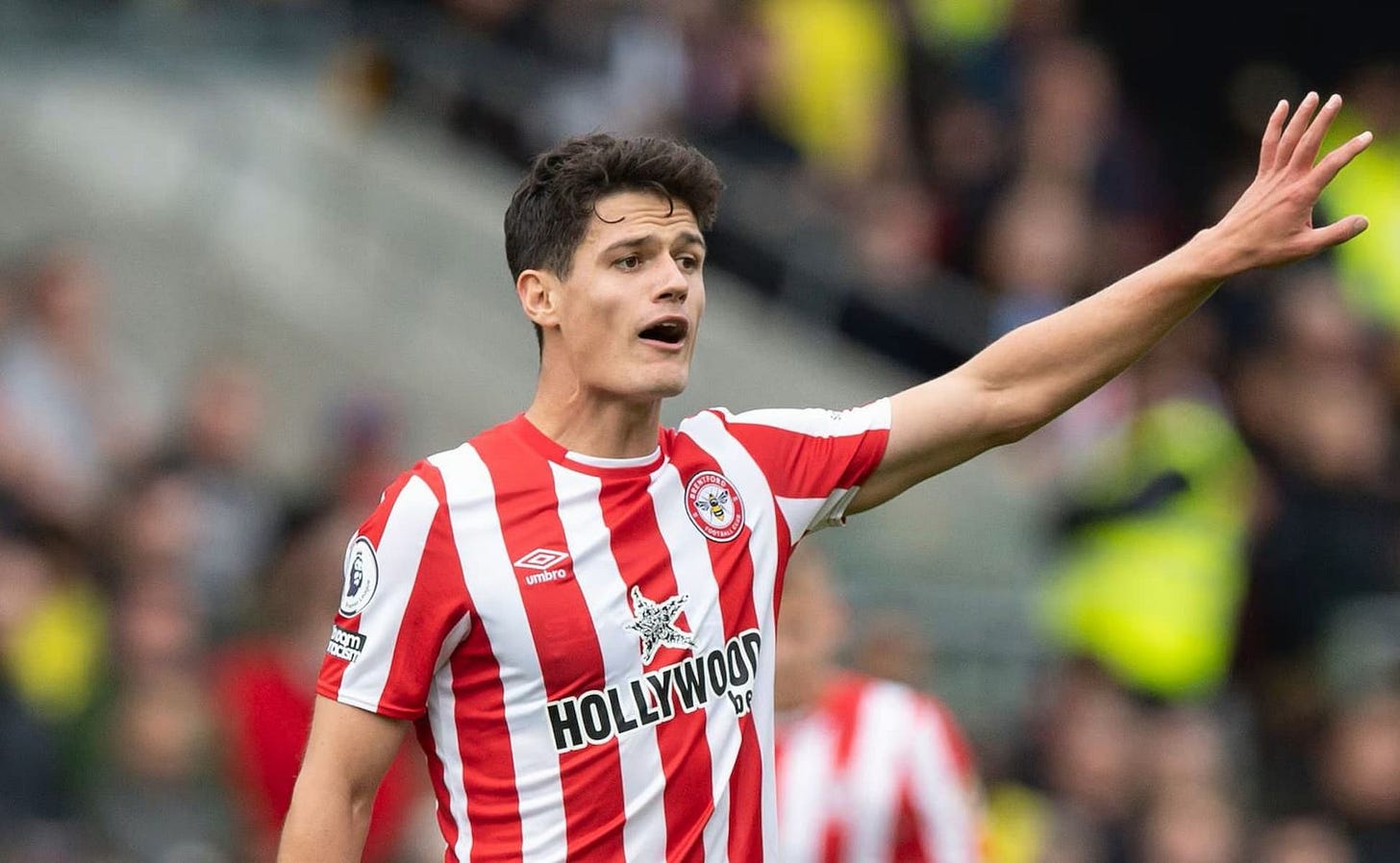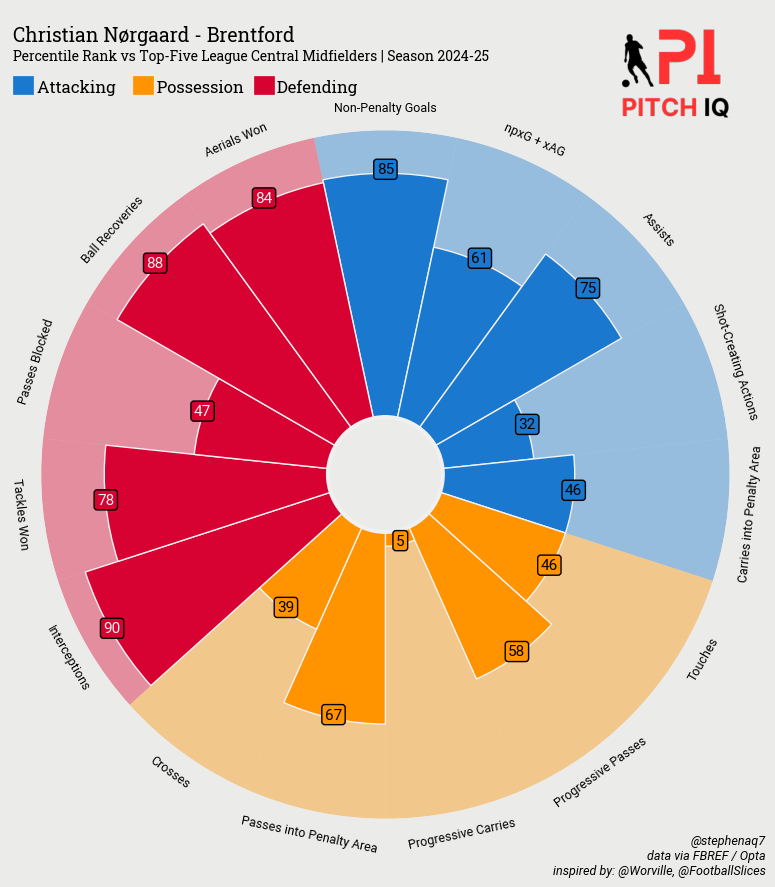Guard Duty, Nørgaard vs Agoumé for Arsenal’s Pivot Plan B
Arsenal’s Back-Up DM Decision Comes Down to Risk, Rhythm, and Respect
Martín Zubimendi is all but an Arsenal player. At this point, it’s just paperwork. With the legal and financial dust settling, Mikel Arteta is set to get his tactical metronome, the deep pivot to release Declan Rice and restore balance to the midfield.
But one signing doesn’t complete the puzzle. Arsenal now need a back-up six. Someone who can hold shape when Zubimendi rests. Someone who doesn’t disrupt the system when plugged in. Someone who can allow Rice to remain as the free 8 when needed.
Two names have quietly emerged at the top of that shortlist: Christian Nørgaard and Lucien Agoumé.
They are polar opposites in age, club stature, and experience, but they both make tactical sense. The decision now is about risk, pressure, and protecting Arsenal’s long-term balance.
Zubimendi Sets the Standard
Zubimendi’s arrival (pending final confirmation) signals a shift. No more midfield improvisation. No more patching holes with double pivots or half-fits. Arsenal will have a true controller, press-resistant, spatially aware, and positionally disciplined.
That creates two urgent needs:
A natural rotation option who can offer similar stability
A supporting cast that allows Ødegaard and Rice to do what they do best
Whoever comes in must complement this system. Not complicate it.
Christian Nørgaard: The Unflashy Fit
Nørgaard isn’t an exciting name. He’s 31. He plays for mid-table Brentford. He doesn’t pass the “Twitter comp test.” But that undersells how quietly effective he’s been over multiple Premier League seasons.
He reads the game better than most. He positions himself early. He tackles cleanly and fouls smartly. And while his passing is functional rather than expansive, it’s composed, which is often all you need when the team is already full of carriers.
He’s also experienced in the league, physically ready to step in, and mentally attuned to high-pressure games. He’s performed well against big six opposition. There’s no learning curve. He knows the league, the pace, the spacing, and the off-ball patterns.
The key factor here is balance. In a best-case scenario, Nørgaard becomes a youthful upgrade on Jorginho, helps manage the rhythm of big matches, frees Ødegaard from excessive build-up responsibility, and covers Zubimendi without destabilising the entire midfield.
He’s also an ideal transitional piece to protect Miles Lewis-Skelly’s pathway, a player who could evolve into a six or an eight. You’re not blocking him. You’re giving him space and time to find his feet.
Lucien Agoumé: The High-Ceiling Gamble
Lucien Agoumé, meanwhile, is a very different proposition. At 23, he’s still mostly unproven. He’s been on the books at Inter, loaned to Brest, Troyes, and Sevilla. The flashes are there, technical control, press resistance, verticality.
Agoumé’s standout trait is his composure under pressure. He’s comfortable receiving with his back to play, escapes tight spaces with minimal touches, and shows awareness of nearby pressure. His passes break lines, not just recycle possession.
But that’s the upside. The downside is real. He’s rarely had a full season of starts. His injury record isn’t spotless. And he hasn’t yet played in a system with Arsenal’s defensive precision and positional discipline.
And this is the key problem: if Agoumé signs and Zubimendi struggles early or gets injured, Agoumé would inherit enormous pressure. That’s unfair on both players. And it could disrupt the Rice-Ødegaard dynamic the club has worked so hard to build.
ML DoF Spotlight: Other Names via Euclidean KNN
As part of the ML DoF project, I ran a similarity model using Euclidean K-Nearest Neighbours (KNN) to identify players with a statistical profile similar to Thomas Partey, using weighted metrics for passing, defending, creation, and shooting. The data is built from FBref aggregates for the 2024–25 season and limited to players aged under 25 across the top five European leagues.
The closest matches in the model include Oussama Targhalline, Albert Sambi Lokonga, Valentin Rongier, Djaou Cissé, and Harry Winks. These players scored between 87 and 89 percent similarity to Partey, based on aggregate performance rather than role-specific nuance. Most offer good defensive activity and safe passing but generally lack Partey’s verticality and transitional awareness.
There are more well-known names further down the list. Eduardo Camavinga appears with a solid 86 percent similarity, but as most watchers know, his usage at Real Madrid has been varied. Youssouf Fofana, Nicolò Rovella, Ryan Gravenberch, and Lucien Agoumé also appear in the 83 to 85 percent range, each offering different stylistic strengths but none with the full spectrum of Partey’s peak game.
This leads to some important limitations.
First, the model is entirely output-based. It does not account for tactical instruction, team structure, or the level of competition faced.
Second, similarity scores reflect statistical proximity, not positional interchangeability. For example, some players high on the list have better numbers in specific categories but play more advanced or wider roles.
Third, it cannot capture intangibles like experience, adaptability under pressure, or how well a player complements teammates like Rice or Ødegaard in a controlled buildup system.
Despite these constraints, the data supports one clear insight. Most of the closest matches to Partey either lack top-level experience or come with a development curve. That makes them questionable fits for a role that demands immediate clarity and structure.
It reinforces the argument that signing a stable, league-tested backup like Christian Nørgaard is not just about the floor he offers, but the lack of truly viable alternatives without taking on risk in other areas of the pitch or squad harmony.
Squad Culture and Role Acceptance
There’s also the dressing room question. Jorginho worked because he didn’t rock the boat. Nørgaard would be the same. A seasoned pro who trains hard, accepts his role, and helps build squad culture.
Agoumé might do that too but you’re guessing and Arsenal are done guessing. This team is too close to contention for unnecessary friction.
The Rice & Ødegaard Factor
One reason Nørgaard makes so much sense? He unlocks both Rice and Ødegaard simultaneously.
With Nørgaard sitting, Rice plays higher and breaks lines without having to playmake from the base
Ødegaard gets to start possessions higher, receive the ball facing forward, and focus on linking with Saka and the striker
It’s a reversion to his 22/23 and 23/24 form, when his touches were fewer but more decisive.
You don’t just sign Nørgaard for the DM minutes. You sign him for the cascading effect.
Miles Lewis-Skelly: The Bigger Picture
Perhaps the most overlooked element in all this is Miles Lewis-Skelly. Arsenal know they have something special. But he’s still only 18. Throwing him into the 6 role too early could backfire. Buying someone like Agoumé might clog his path.
Nørgaard? He’s a perfect bridge. A two-year player who starts the Carabao Cup and holds the line in December. He gives MLS time to define himself, as an eight or a six without the microscope.
With Mikel Merino also joining the squad, the midfield is strong. But it’s not locked. One wrong piece here could stunt the entire rotation.
Final Thoughts
Arsenal have done the hard part. Zubimendi is coming. The midfield is about to enter its next evolution.
Now the club must decide how to protect it.
Christian Nørgaard gives you security, experience, and harmony.
Lucien Agoumé offers upside, ball progression, and future resale.
For me, the answer is clear. Arsenal don’t need another high-risk bet. They need someone who already knows how to win ugly, manage big games, and maintain structure.
Nørgaard may not excite, but he’s what this squad needs. And most importantly, he keeps the door open for Miles Lewis-Skelly to walk through when the time is right.
Thanks for reading,
Steve













